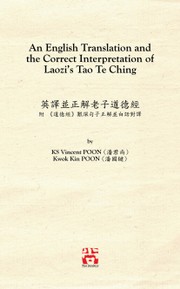Tao Te Ching
道德經
Background information
Tao Te Ching (《道德經》, or Dao De Jing), presumably written by Laozi (老子) of the 6th century BC, is one of the most famous and influential philosophical works in Chinese history. Written in fewer than 6000 Chinese characters, Tao Te Ching outlines the characteristics and roles of the fundamental Tao (道) and its Te (德, Manifestation of Tao) in the formation and maintenance of all in the Universe. Remarkably, it also depicts the underlying nature of governance and some natural laws, which, surprisingly, include modern scientific concepts such as atomic theory, chemical equilibrium, polarities, and the quantum uncertainty principle.
Unfortunately, Tao Te Ching is often misinterpreted by many for more than two thousand years. Their failures are mainly attributed to applying Taoist Religion (道教), Huang-Lao (黄老), and Confucian concepts in interpreting characters such as “鬼”, “神”, “仁”, “慈”, “善”, and “德”. Further, “若”, “似”, and “或” are also frequently misinterpreted, giving rise to the incorrect impression that Laozi was a scheming and calculating philosopher. Prominent interpreters of the past and present, including Heshang Gong (河上公), Wang Bi (王弼), Gao Heng (高亨), and James Legge, have all committed these types of errors in varying degrees.
This book provides readers with an annotated, line-by-line, concise, consistent, and correct English translation and interpretation of Tao Te Ching. Accompanied 674 footnotes include references and brief discussions on general misunderstandings. Further, to facilitate easy reading, the bare translated text is supplemented in a separate section, while the correct interpretation of difficult and complex sentences in vernacular Chinese (《道德經》艱深句子正解並白話對譯) in another. Accordingly, this book is perfect for anyone interested in Chinese philosophy.
Original Chinese Text
(Wang Bi's 王弼 Edition)
English Interpretation
by KS Vincent Poon (潘君尚) and Kwok Kin Poon (潘國鍵)
第四十五章 Chapter 45
____
126. 大成若缺,其用不弊。大盈若沖,其用不窮。大直若屈,大巧若拙,大辯若訥。
The most accomplished (大成) is (若) actually still deficient (缺), but its applications are inexhaustible (不弊); the most abundant (大盈) is actually hollow and empty (沖), but its applications are limitless. The strictest and the most proper (大直) is actually submissive and yielding (屈) to Tao; the sharpest and the most brilliant (大巧) is actually dim-witted (拙); the most eloquent (大辯) is actually inarticulate (訥).
127. 躁勝寒靜勝熱。清靜為天下正。
第四十六章 Chapter 46
128. 天下有道,卻走馬以糞。天下無道,戎馬生於郊。
129. 禍莫大於不知足;咎莫大於欲得。故知足之足,常足矣。
第四十七章 Chapter 47
130. 不出戶知天下;不闚牖見天道。其出彌遠,其知彌少。
131. 是以聖人不行而知,不見而名,不為而成。
第四十八章 Chapter 48
132. 為學日益,為道日損。損之又損,以至於無為。無為而無不為。
133. 取天下常以無事,及其有事,不足以取天下。
第四十九章 Chapter 49
134. 聖人無常心,以百姓心為心。善者,吾善之;不善者,吾亦善之;德善。
135. 信者,吾信之;不信者,吾亦信之;德信。
136. 聖人在天下,歙歙為天下渾其心,百姓皆注其耳目,聖人皆孩之。
第五十章 Chapter 50
137. 出生入死。生之徒,十有三;死之徒,十有三;人之生,動之死地,十有三。夫何故?以其生,生之厚。
138. 蓋聞善攝生者,陸行不遇兕虎,入軍不被甲兵;兕無所投其角,虎無所措其爪,兵無所容其刃。 夫何故?以其無死地。
第五十一章 Chapter 51
139. 道生之,德畜之,物形之,勢成之。是以萬物莫不尊道而貴德。
140. 道之尊,德之貴,夫莫之命常自然。故道生之,德畜之;長之育之;亭之毒之;養之覆之。生而不有,為而不恃,長而不宰,是謂玄德。
第五十二章 Chapter 52
141. 天下有始,以為天下母。既得其母,以知其子,既知其子,復守其母,沒身不殆。
142. 塞其兌,閉其門,終身不勤。開其兌,濟其事,終身不救。
143. 見小曰明,守柔曰強。用其光,復歸其明,無遺身殃;是為習常。
第五十三章 Chapter 53
144. 使我介然有知,行於大道,唯施是畏。大道甚夷,而民好徑。
145. 朝甚除,田甚蕪,倉甚虛;服文綵,帶利劍,厭飲食,財貨有餘;是謂盜夸。非道也哉!
第五十四章 Chapter 54
146. 善建不拔,善抱者不脫,子孫以祭祀不輟。
147. 修之於身,其德乃真;修之於家,其德乃餘;修之於鄉,其德乃長;修之於國,其德乃豐;修之於天下,其德乃普。
148. 故以身觀身,以家觀家,以鄉觀鄉,以國觀國,以天下觀天下。吾何以知天下然哉?以此。
第五十五章 Chapter 55
149. 含德之厚,比於赤子。蜂蠆虺蛇不螫,猛獸不據,攫鳥不搏。骨弱筋柔而握固。
150. 未知牝牡之合而全作,精之至也。終日號而不嗄,和之至也。知和曰常,知常曰明。
151. 益生曰祥,心使氣曰強。物壯則老,謂之不道,不道早已。
Rash and fiery actions (躁) may temporarily overcome icy and hostile situations (寒), yet it is tranquillity (靜) that shall ultimately and inexhaustibly overcome boiling fierceness (熱). Pristine tranquillity (清靜) is the true guiding principle (正) of all under Heaven.
FOR FURTHER TRANSLATION, FOOTNOTES, AND ELABORATIONS
PLEASE SEE :

An English Translation and the Correct Interpretation of Laozi’s Tao Te Ching 英譯並正解老子道德經 附 《道德經》艱深句子正解並白話對譯
by KS Vincent POON and Kwok Kin POON (July. 2020)
ISBN 978-1-989485-15-6
Tao Te Ching (《道德經》, or Dao De Jing), presumably written by Laozi (老子) of the 6th century BC, is one of the most famous and influential philosophical works in Chinese history. Written in fewer than 6000 Chinese characters, Tao Te Ching outlines the characteristics and roles of the fundamental Tao (道) and its Te (德, Manifestation of Tao) in the formation and maintenance of all in the Universe. Remarkably, it also depicts the underlying nature of governance and some natural laws, which, surprisingly, include modern scientific concepts such as atomic theory, chemical equilibrium, polarities, and the quantum uncertainty principle.
Unfortunately, Tao Te Ching is often misinterpreted by many for more than two thousand years. Their failures are mainly attributed to applying Taoist Religion (道教), Huang-Lao (黄老), and Confucian concepts in interpreting characters such as “鬼”, “神”, “仁”, “慈”, “善”, and “德”. Further, “若”, “似”, and “或” are also frequently misinterpreted, giving rise to the incorrect impression that Laozi was a scheming and calculating philosopher. Prominent interpreters of the past and present, including Heshang Gong (河上公), Wang Bi (王弼), Gao Heng (高亨), and James Legge, have all committed these types of errors in varying degrees.
This book provides readers with an annotated, line-by-line, concise, consistent, and correct English translation and interpretation of Tao Te Ching. Accompanied 674 footnotes include references and brief discussions on general misunderstandings. Further, to facilitate easy reading, the bare translated text is supplemented in a separate section, while the correct interpretation of difficult and complex sentences in vernacular Chinese (《道德經》艱深句子正解並白話對譯) in another. Accordingly, this book is perfect for anyone interested in Chinese philosophy.
WorldCat/Library: [WorldCat] [U of Oxford] [U of Cambridge] [Harvard U] [Kyoto U] [National Taiwan U] [HKU] [CUHK]etc...
Jump to: Taoism
Jump to: Works in Standard Script